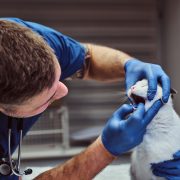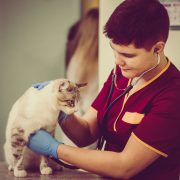Understanding the barriers to blood pressure assessment in cats
Understanding the barriers to blood pressure assessment in cats

Open access
In our edition of: Oct 2023
In our categories of: small animals
our summary:
Caney, S.M.A. et al. (2023) Understanding the barriers to blood pressure assessment in cats. Journal of Feline Medicine and Surgery, 25 (8).
The aims of this online questionnaire survey study were to determine current practices, including equipment used and protocols, and information on barriers to blood pressure (BP) assessment including whether these related to time, equipment, space or factors relating to either the owner or the cat.
The survey was open to veterinary surgeons or veterinary nurses working in clinical practice with feline patients from May-July 2022. It was emailed to all veterinary surgeons and veterinary nurses on the Vet Professionals database and promoted on social and other media and by relevant organisations. The survey included questions on whether BP measurement took place in the clinic or at the patient’s home, the equipment used and methods and protocols relating to its use, frequency of recommendation of BP assessment, indications for making a BP recommendation, and proportion of owners that accepted this recommendation. Questions on barriers to BP assessment related to the equipment, time, procedure, patients, owners and whether the COVID-19 pandemic had impacted BP assessment in their clinic.
A total of 545 completed and 85 partially completed responses were received meaning 630 responses were included in the study. Almost all (n=613) worked in a clinic with access to a BP monitor. Of those with access to a monitor most (n=550) had access to a Doppler monitor, 367 had access to multiparameter monitors and 202 to oscillometric BP monitors. Doppler monitors were most commonly chosen for conscious cat measurements with respondents commenting on their greater ‘trust’ and ‘reliability’ compared with oscillometric machines. Two members of staff were typically involved with conscious BP measurement.
Of the respondents who answered the question on frequency of BP assessment recommendation only 156 (29.1%) participants recommended BP assessment several times a week in their interactions with cat owners. BP assessment was routinely recommended for cats with ocular target organ damage, but was less commonly recommended for chronic kidney disease, proteinuria and hyperthyroidism. Common equipment-related barriers included ‘cuff frustration’, difficulties hearing the pulse signal for Doppler users, and oscillometric machines failing to give a reading at some of the time.
Barriers relating to the patient included concerns with situational hypertension and lack of time to do the procedure. Barriers relating to owners included difficulties persuading them to bring their cat in for BP checks and concerns over costs. Most participants had access to a direct ophthalmoscope; however there was reported concern over ability to interpret ocular findings.
Limitations of the study include potential selection bias of the respondents and possible recall bias.
This study provides useful information on the current practice relation to BP measurements, highlighting barriers that exist and suggesting possible solutions. The responses showed that there is a demand for additional practical training and support to assist with BP measurement. Specific areas highlighted for training included obtaining reliable BP readings and performing eye examinations.
The following may also be of interest:
Taylor, S.S. et al. (2017) ISFM consensus guidelines on the diagnosis and management of hypertension in cats. Journal of Feline Medicine and Surgery, 19 (3) pp. 288-303. https://doi.org/10.1177/1098612X17693500
The June 2017 edition of inFOCUS contains a summary of this paper.
Caney, S. (2021) Feline blood pressure measurement: when is it needed? Companion Animal, 26 (11), pp. 222-228. https://doi.org/10.12968/coan.2021.0063
The February 2022 edition of inFOCUS contains a summary of this paper.
International Society of Feline Medicine (2020) Practical recommendations on the measurement of indirect blood pressure in cats. Tisbury, ISFM. Available from: https://icatcare.org/app/uploads/2020/05/ISFM-BP-recommendations.pdf [Accessed 22 October 2023]
Claiming CPD for reading inFOCUS articles
Reading and reflecting on articles can count towards your CPD, and we have a template to help you with the process.
Image copyright attribute: Copyright: herraez






Leave a Reply
Want to join the discussion?Feel free to contribute!